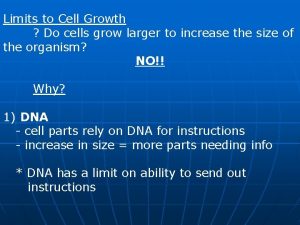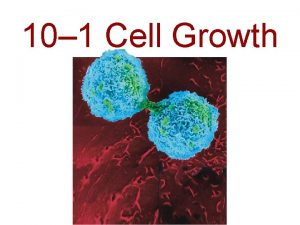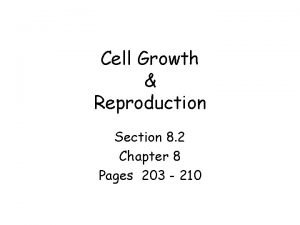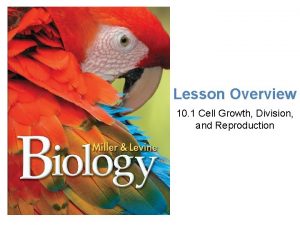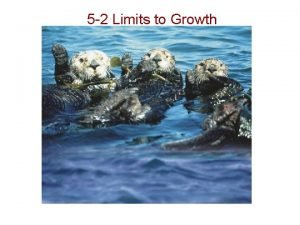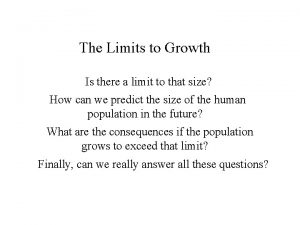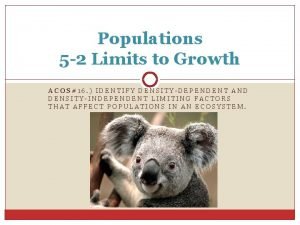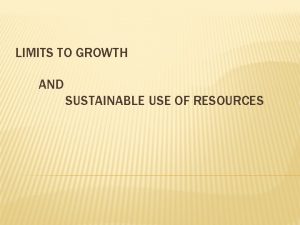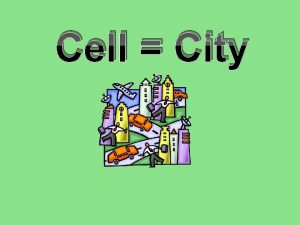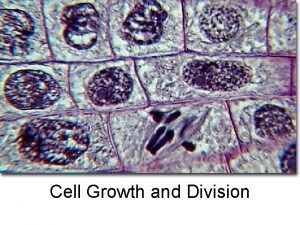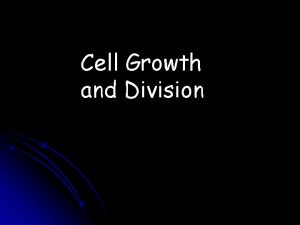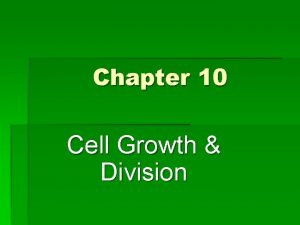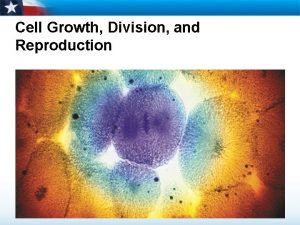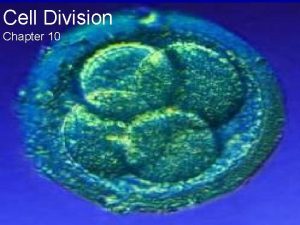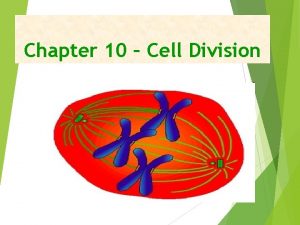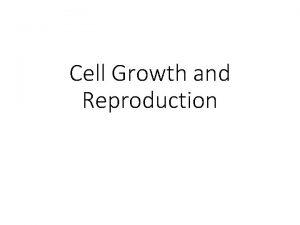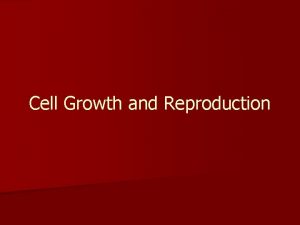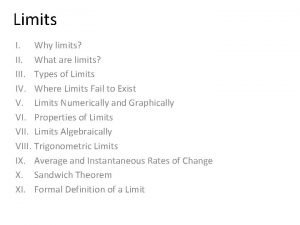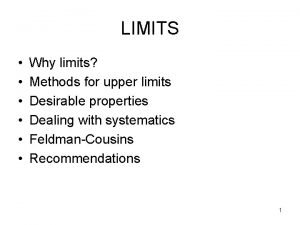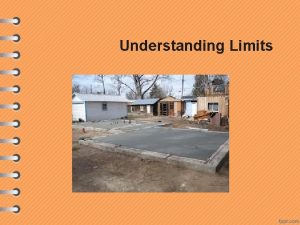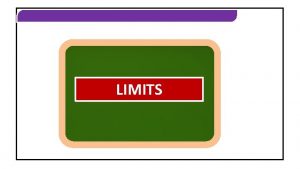Cell Growth and Division Limits to growth Cell




















- Slides: 20

Cell Growth and Division

• Limits to growth Cell Growth – Stress on DNA – Difficulty moving nutrients/wastes across membrane • Ratio of surface area to volume • Volume increases at a faster rate than surface area

Cell Division • Before a cell becomes too large, it divides, producing 2 daughter cells – Each daughter cell is an exact replica of the parent cell • DNA is replicated

Cell Division • 2 stages (eukaryotes) – Mitosis- division of the cell nucleus – Cytokinesis- division of the cytoplasm • Asexual reproduction

Chromosomes • Threadlike structure within the nucleus containing the genetic information (DNA) that is passed from one generation of cells to the next • Cells of every organism have a specific number of chromosomes – Fruit flies = 8; Humans = 46; carrots = 18

Chromosomes • Chromatin- consists of DNA tightly coiled around proteins (nucleus) • Chromatid- one of two identical “sister” parts of a duplicated chromosome • Centromere- an area where the chromatids are attached to one another



The Cell Cycle • 2 major phases – Interphase – Mitosis

Interphase • 3 phases – G 1 phase= cells do most of their growing – S phase= chromosomes and DNA replicated – G 2 phase= many of the organelles and molecules required for cell division are produced

Mitosis • Divided into 4 phases – Prophase – Metaphase – Anaphase – Telophase • Followed with Cytokinesis • Depending on cell- may last a few minutes to several days

Prophase • 1 st and longest phase of mitosis • Events – Chromosomes become visible – Nucleolus disappears – Nuclear envelope breaks down

Metaphase • Often lasts only a few minutes • Events – Chromosomes line up across the center of the cell – Microtubules connect the centromere of each chromosome to the two poles of the spindle

Anaphase • Sister chromatids separate and move to opposite poles • Anaphase ends when chromosomes stop moving

Telophase • Nuclear envelope reforms • Spindle begins to break apart • Nucleolus becomes visible

Cytokinesis • Animal cells: – Cell membrane is drawn inward until the cytoplasm is pinched into 2 nearly equal parts • Plant cells: – Cell plate forms midway between the divided nuclei – Cell wall begins to appear in the cell plate • Result? 2 new identical cells


Controls on Cell Division • Cells stop growing when they come into contact with other cells • If cells are removed, the remaining cells will begin dividing again • Something can turn cell division on or off

Regulating Cell Growth • Cyclins- proteins that regulate the timing of the cell cycle in eukaryotic cells – Internal regulators: proteins that respond to events inside the cell – External regulators: proteins that respond to events outside the cell

Uncontrolled Cell Growth • Cancer- disorder in which some of the body’s own cells lose the ability to control growth • Cancer cells do not respond to the signals that regulate the growth of most cells
 Limits involving infinity asymptotes
Limits involving infinity asymptotes Limits to cell growth
Limits to cell growth Limits to cell growth
Limits to cell growth Real limits
Real limits Section 8-2 cell division
Section 8-2 cell division Cell growth division and reproduction
Cell growth division and reproduction Cell cycle and cell division
Cell cycle and cell division Cell cycle and cell division
Cell cycle and cell division Steps of cell cycle
Steps of cell cycle When do density-dependent factors operate most strongly
When do density-dependent factors operate most strongly Limits to growth
Limits to growth 5-2 limits to growth
5-2 limits to growth Limits to growth
Limits to growth Long division and short division
Long division and short division Parts of long division
Parts of long division Synthetic division of polynomials
Synthetic division of polynomials Divide using synthetic division
Divide using synthetic division The surface area to volume ratio of a cell limits
The surface area to volume ratio of a cell limits City limits cell part
City limits cell part Plant growth definition
Plant growth definition Monocots eudicots
Monocots eudicots

